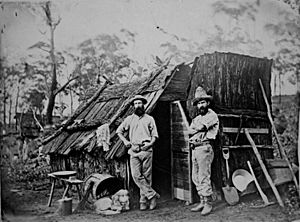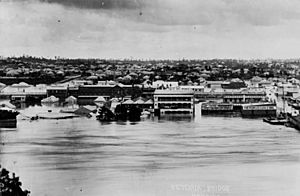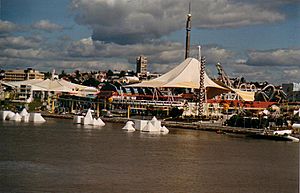History of Queensland facts for kids
The history of Queensland is a story of both the Aboriginal people who have lived there for thousands of years and the more recent times of European settlement. Before Lieutenant James Cook claimed the land for Britain in 1770, Dutch and French explorers had already sailed along the coast. Queensland became a separate self-governing area from New South Wales in 1859. Then, in 1901, it joined five other areas to become one of the first states of Australia.
Contents
Indigenous People: First Australians
A long, long time ago, between 50,000 and 60,000 years ago, Aboriginal people arrived in Australia. They likely came by boat or across land bridges from Southeast Asia, possibly through the Torres Strait. Over many thousands of years, they explored and settled across most of the continent.
Around 25,000 years ago, a big ice age started, making the Earth much colder. This cold period lasted over 10,000 years. It became hard to find food, which led to new ways of living, like grinding seeds for food.
About 15,000 years ago, the world started to warm up again, and it rained more along Australia's east coast. The inland parts of Queensland also got more rain and became good places to live. As sea levels rose, some coastal lands disappeared, and tropical rainforests grew. The Kalkadoon people, who lived inland, even dug wells up to 10 meters deep to get fresh water.
From 10,000 years ago until Europeans arrived, the warmer weather helped people build semi-permanent villages in the northern rainforests, the far west, and around Moreton Bay. Along the Barron River and on the islands of Moreton Bay, large huts were built that could house many people. However, because of droughts and floods, most Aboriginal people in Queensland continued to live as hunter-gatherers, moving to find food.
The exact number of Aboriginal people in Queensland before Europeans arrived is not known for sure, but it might have been between 200,000 and 500,000. Queensland was one of the most populated areas, with many different Aboriginal nations and at least ninety language groups.
European Exploration and Early Settlement
Early Explorers
In 1606, a Dutch sailor named Willem Janszoon landed near where the town of Weipa is today. This was the first time Europeans and Aboriginal Australians were known to have met.
In 1614, Luis Váez de Torres, a Spanish explorer, might have seen the Queensland coast. He sailed through the Torres Strait, which is now named after him.
In 1768, French explorer Louis Antoine de Bougainville sailed close to the Queensland coast but couldn't get through the coral reefs, so he turned back.
Lieutenant James Cook claimed the east coast of Australia for Britain on 22 August 1770, calling it "New South Wales." This included what is now Queensland. Cook mapped the coast in his ship, the HM Barque "Endeavour". He named many places, like Stradbroke Island, Moreton Island, the Glass House Mountains, and Hervey Bay. His ship got stuck on a coral reef near Cape Tribulation, and they spent almost seven weeks repairing it near where Cooktown is now.
In 1799, Matthew Flinders explored the Queensland coast in his ship, the Norfolk. Later, his ship ran aground on a coral reef. Flinders bravely sailed to Sydney in a small boat to get help for his crew.
First Settlements
In 1823, John Oxley sailed north from Sydney to look for good places for a prison colony. At Moreton Bay, he found the Brisbane River and explored its lower parts. In September 1824, a temporary settlement was set up at Redcliffe. On 2 December, the settlement moved to where downtown Brisbane is now. It was first called Edenglassie, combining the names of two Scottish cities, Edinburgh and Glasgow.
In 1825, Major Edmund Lockyer found coal along the Brisbane River. In 1839, the prison settlement in Brisbane closed, and in 1842, free settlers were allowed to move in.
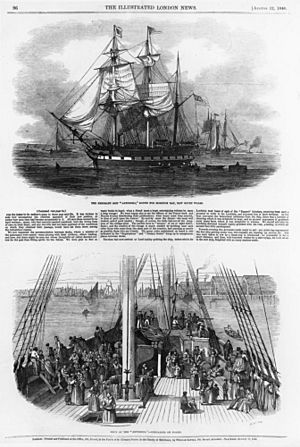
In 1847, the Port of Maryborough opened for wool trade. The first ship carrying immigrants to Moreton Bay was the Artemisia in 1848. Queensland's first lighthouse was built at Cape Moreton in 1857.
Frontier Conflicts
There were many conflicts between Aboriginal people and European settlers in Queensland. These conflicts were more intense than in other parts of Australia, partly because Queensland had a very large Aboriginal population before European arrival. Studies suggest that around 1,500 European settlers and their allies died in these conflicts during the 1800s. The number of Aboriginal people who died was much higher, possibly over 65,000. The Native Police Force, set up by the Queensland government, played a big role in these events.
Some of the largest attacks by Aboriginal people on white settlers in Australian history happened in Queensland. For example, in 1857, 11 Europeans died at Hornet Bank station. In 1861, 19 people, including a grazier named Horatio Wills, were killed at Cullin-La-Ringo. After a shipwreck in 1859, 14 European survivors were killed by local Aboriginal people near the Whitsunday Islands.
Queensland Becomes a Colony
In 1851, people started talking about Queensland becoming separate from New South Wales. On 6 June 1859, Queen Victoria officially signed the papers to create the colony of Queensland. On 10 December 1859, Queensland formally separated from New South Wales. George Bowen became the first Governor, and Robert Herbert became the first Premier.
Queensland was special because it started with its own parliament right away, unlike other Australian colonies that were first ruled directly by the British Crown. Ipswich and Rockhampton became towns in 1860, followed by Maryborough and Warwick in 1861.
In 1861, rescue teams looking for the lost Burke and Wills explorers also did some exploring in central and north-western Queensland. Brisbane got its first electric telegraph link to Sydney in 1861.
Gold Rush in Queensland
Queensland had its own gold rushes in the late 1800s, though they were smaller than those in Victoria and New South Wales. Gold was found at Canoona in 1858 and Gympie in 1867. Explorations by Richard Daintree led to more goldfields in North Queensland. In 1872, William Hann found gold on the Palmer River. Many Chinese settlers came to work on the goldfields. By 1877, there were 17,000 Chinese people on Queensland goldfields, and new rules were made about who could come into the country.
Other Important Events in the 1800s
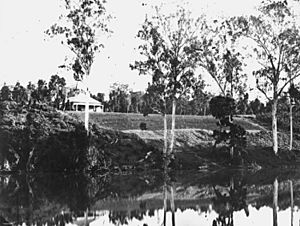

In 1862, Queensland's western border was changed. In 1863, Sir James Cockle became the first Chief Justice. The year 1864 was a tough one for Queensland. In March, a major flood hit Brisbane, and in April and December, fires destroyed much of the main shopping area.
In 1865, the first steam trains in Queensland ran from Ipswich to Grandchester. Townsville was also made a town that year. By 1867, sugar production was becoming a huge industry. It started near Brisbane and spread to Mackay and Cairns. By 1888, Queensland produced 60,000 tons of sugar each year.
The first rugby match in Queensland was played in 1876. In 1881, the first meat was processed in the state at Queensport.
In 1883, Queensland Premier Sir Thomas McIlwraith tried to claim Papua (now part of Papua New Guinea), but the British government didn't agree. Queensland's population passed 250,000 that year. By 1888, there were over 5 million cattle in Queensland, and many railway lines were being built to connect different parts of the state.
In 1891, the Great Shearers' Strike happened at Barcaldine. This strike, about whether employers could use non-union workers, led to the creation of the Australian Labor Party. There were more strikes and some unrest, but union-backed candidates won many seats in the 1893 elections. The 1893 Brisbane flood caused a lot of damage, even destroying the Victoria Bridge.

In 1899, the world's first Labor Party Government, led by Anderson Dawson, was elected in Queensland, but it only lasted one week. Queensland also offered to send soldiers to help Britain in the Second Boer War. Gold production at Charters Towers was at its highest. In 1900, the first natural gas in Queensland was found at Roma. The Mahina Cyclone of 1899 hit Cape York Peninsula, causing Queensland's worst sea disaster and killing about 400 people.
Immigration and Workers
During the 1890s, many workers called Kanakas came to Queensland from nearby Pacific Islands to work in the sugar cane fields. Some of these workers were taken against their will, a practice known as Blackbirding. When Australia became a federation in 1901, the White Australia policy was introduced. This policy meant that most foreign workers in Australia had to leave. Between 7,000 and 10,000 Pacific Islanders were living in Queensland at that time, and most were sent back to their home countries by 1908.
Twentieth Century: A New Era
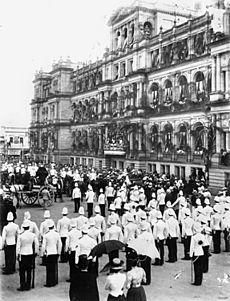
From Federation to World War I
On 1 January 1901, Australia became a federation, uniting its colonies into one nation. Queensland had half a million people at this time. Brisbane was officially declared a city in 1902. In 1905, women voted in state elections for the first time. In 1908, Witches Falls, part of Tamborine National Park, became Queensland's first national park. The University of Queensland was started in 1909. In 1912, the 1912 Brisbane General Strike lasted for five weeks.
World War I: Queensland's Role
When the United Kingdom declared war on Germany on 4 August 1914, Queensland made its own declaration of war. This was because Australia's new constitution didn't say who declared war. Queensland also declared war on other countries later.
At first, the war in Europe didn't change life much in Queensland. However, many Queenslanders volunteered to join the Australian Imperial Force. The army could choose only the fittest men because so many wanted to join. Women were mostly accepted as nurses. Some Queensland women doctors, like Lilian Violet Cooper and Eleanor Bourne, found ways to help the war effort overseas since the Australian army didn't accept them as doctors. Annie Wheeler, a nurse, stayed in London and helped Central Queensland soldiers and their families.
On 10 January 1916, Canon David John Garland helped create the Anzac Day Commemoration Committee of Queensland. He is credited with starting many of the traditions we see on Anzac Day today, like the march, wreath-laying, church services, and the two minutes of silence. He wanted Anzac Day to be a day for everyone to remember, no matter their religion.
Over 58,000 Queenslanders fought in World War I, and more than 10,000 of them died. In 1918, Queensland had its largest recorded earthquake near Rockhampton.
Between the Wars: Growth and Change
Qantas airline was founded in 1920 to serve remote Queensland. In 1921, the Mount Mulligan mine disaster killed 75 workers. In 1922, the Queensland Legislative Council was removed, making Queensland the only Australian state with only one house of parliament. The Traverston rail disaster in 1925 was the worst rail disaster in Queensland's history until 1947.
In 1927, the Duke and Duchess of York visited Queensland. In 1928, the Royal Flying Doctor Service of Australia made its first flight from Cloncurry. Also in 1928, Sir Charles Kingsford Smith landed his plane, the Southern Cross, in Brisbane, completing the first flight across the Pacific Ocean.
In 1935, 101 Cane Toads were brought to Queensland to help control pests on sugar cane crops. They bred quickly and spread to many parts of Queensland and other states. In 1936, a lightning strike destroyed the Bundaberg Rum Distillery, but it was rebuilt.
World War II: A Frontline State
During World War II, many Queenslanders joined the Australian armed forces. After war broke out with Japan, Queensland became very important as a "frontline" area, and people worried about invasion. Japanese planes bombed several places in Northern Queensland, including Horn Island, Townsville, and Mossman.
Many Australian and United States soldiers gathered in Queensland. General Douglas MacArthur, the Allied Supreme Commander in the South West Pacific, set up his headquarters in Brisbane. New camps and facilities were built to train these forces.
On 14 May 1943, the Australian Hospital Ship Centaur was sunk off North Stradbroke Island by a Japanese submarine. Later in the war, Queensland soldiers fought in the Bougainville campaign.
Post-War Queensland
The 1948 Queensland Railway strike lasted nine weeks over workers' wages. In 1952, Queensland's only whaling station opened at Tangalooma, but it closed ten years later. The Shearers' strike of 1956 saw shearers out of work for many months.
In 1962, the first oil was produced in Queensland and Australia at Moonie. Also that year, a program of drum lines began at beaches to reduce shark attacks. In 1968, Sir Joh Bjelke-Petersen was elected Premier and stayed in that role for 19 years. In 1969, the first natural gas pipeline in Queensland connected the Roma gasfields to Brisbane.
In 1971, there were protests about the 1971 Springbok tour (a rugby tour). Daylight Saving was introduced to Queensland but stopped the next year. The Box Flat Mine explosion killed 18 men in 1972. Two years later, the 1974 Brisbane flood caused widespread damage. In 1976, sand mining on Fraser Island was stopped.
The 1980s: Big Changes
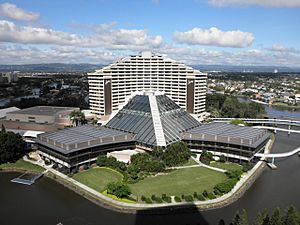
In 1982, Brisbane hosted the Commonwealth Games. That same year, Eddie Mabo began a legal case in the High Court to claim ownership of land in the Torres Strait for the Aboriginal people. The Queensland government tried to stop this case, but in 1988, the High Court ruled against them. The famous Mabo v Queensland (No 2) (1992) decision in 1992 recognized native title, meaning Aboriginal people could claim traditional ownership of land.
In 1987, an investigation called the Fitzgerald Inquiry looked into police corruption in Queensland. This investigation led to big changes in the government, including the resignation of the Premier, and some former ministers and a police commissioner were jailed. Wayne Goss led the Labor Government to power in 1989.
The annual State of Origin series in rugby league began in Brisbane in 1980. In 1987, the Brisbane Bears Australian rules football team joined the national league. Brisbane also hosted games for the first-ever 1987 Rugby World Cup in 1987.
Expo '88 was held in Brisbane in 1988 to celebrate 200 years since the First Fleet arrived in Australia. It was a very successful event that helped show Brisbane and Queensland to the world. Also in 1988, the Brisbane Broncos and Gold Coast-Tweed Giants rugby league teams were formed. In 1989, Queensland started a three-year trial of Daylight Saving. The National Party government was defeated in the state election, and the Labor government, led by Wayne Goss, took over.
The 1990s: Fast Growth
The 1990s saw Queensland's population grow very quickly, mostly because people from other Australian states moved there. They were attracted by Queensland's strong economy and the chance for young families to buy homes more easily than in cities like Sydney. Most of this growth happened in South East Queensland. In 1991, logging on Fraser Island stopped.
By the late 1990s, the fast population growth put pressure on Queensland's roads, railways, electricity, and water systems. Big plans were made to build new infrastructure to handle the growing population, and many of these projects were built in the next decade.
In 1992, Queensland held a vote on Daylight Saving, but it was defeated with 54.5% of people voting "no." In 1998, the use of the Brisbane and Bremer Rivers for carrying coal by barge stopped after 158 years.
The first nature refuge under Queensland's Nature Conservation Act was created in 1994, called "Berlin Scrub," a 41-hectare site in the Lockyer Valley.
The 2000s: New Millennium
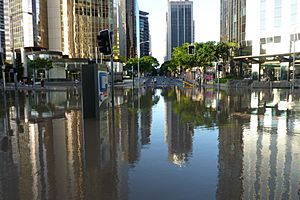
In 2001, the Goodwill Games were held in Brisbane. In 2003, both Brisbane and Townsville hosted games for the 2003 Rugby World Cup. That same year, an oil pipeline burst near Brisbane, causing Queensland's largest-ever oil spill.
Cyclone Larry hit the Queensland coast in March 2006, becoming the most expensive tropical cyclone to ever affect Australia at that time. In 2006, people in Toowoomba voted against using recycled sewage water for drinking, stopping a big water recycling plan.
In 2009, Anna Bligh became Queensland's first female Premier. According to the Bureau of Meteorology, 2010 was Queensland's wettest year on record. At the end of 2010 and into 2011, the state experienced widespread floods. Toowoomba and the Lockyer Valley had very bad flash floods in January. Cyclone Yasi crossed the Queensland coast in February, causing even more damage than Cyclone Larry.
Images for kids
-
Countdown clock for the 2018 Commonwealth Games in Surfers Paradise
See also
 In Spanish: Historia de Queensland para niños
In Spanish: Historia de Queensland para niños


